Illinois is the Prairie State with lush landscapes full of prairie grasses and other intriguing plants. Yet, like every state, some Illinois plants are poisonous for both people and animals. While many plants are harmless, the occasional toxic one can quickly ruin a nature walk or camping trip. So it’s important to brush up on some of the most dangerous plants in the US and Illinois before pitching your tent.
Keep scrolling to check out 10 of the most dangerous plants growing in Illinois today. We’ll look at their growth habits, habitats, and the toxins that make them threatening to you and your pets.

1. Eastern Black Nightshade (Solanum ptychanthum)

Black nightshade is a poisonous plant that produces glossy, purple, or black berries.
©Omhans/Shutterstock.com
The eastern black nightshade is a branching herb and one of the most dangerous plants in Illinois. This poisonous plant has small white or purple flowers and glossy black berries. It also has oval, lance-shaped leaves arranged alternately along the stem.
Eastern black nightshade grows in waste areas, cultivated fields, and along roadsides. But if you find it, stay clear to avoid skin irritation and accidental poisoning.
Eastern Black Nightshade Toxins
This nightshade plant contains solanine, which is a toxic alkaloid. Because of its toxins, touching eastern black nightshade could cause a skin rash. Eating any parts of eastern black nightshade plants could cause gastrointestinal symptoms like diarrhea, stomach cramps, nausea, and vomiting. Additional and more serious symptoms could include dizziness, confusion, an irregular heart rate, slowed breathing, delirium, and paralysis that could lead to death.
2. Pokeweed (Phytolacca americana)
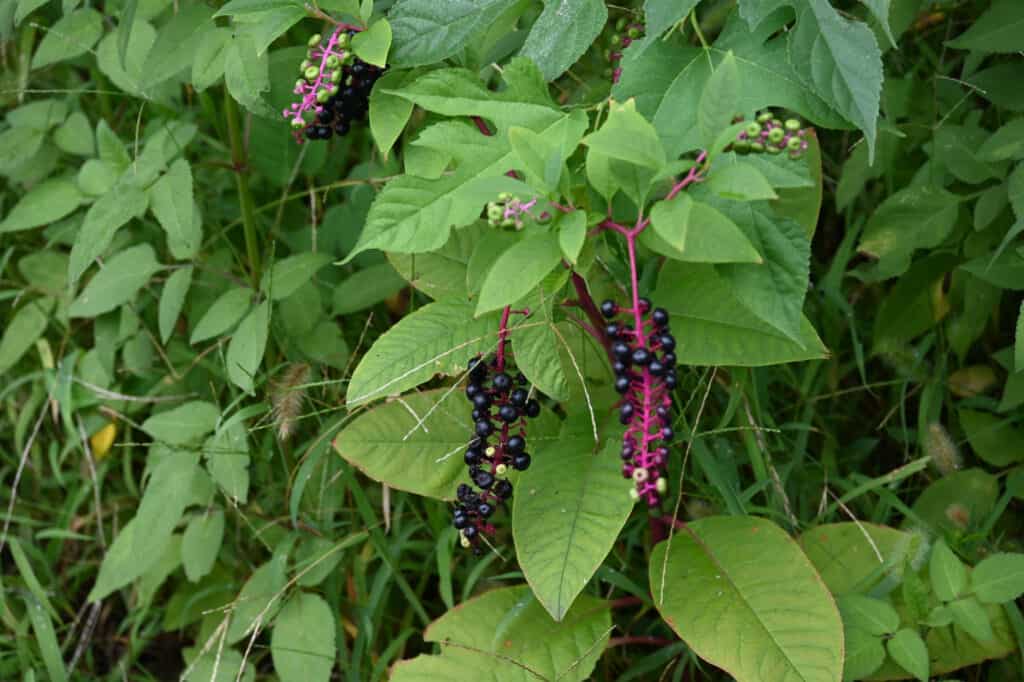
The entire pokeweed plant contains toxins that can cause painful rashes and blisters.
©tamu1500/Shutterstock.com
The pokeweed is a large perennial plant that grows in woodlands, fields, and disturbed areas of Illinois. It has long and smooth reddish-purple stems and oval green leaves. It also produces clusters of small white flowers that develop into dark purple berries.
Pokeweed Toxins
The entire pokeweed plant contains toxins like saponins, mitogen content, and Phytolacca. Touching the pokeweed plant can cause symptoms like an itchy, red rash, and blisters. Ingesting any part of this plant (including the highly poisonous berries) can result in diarrhea, vomiting, convulsions, respiratory failure, and unconsciousness.
3. Jimsonweed (Datura stramonium)
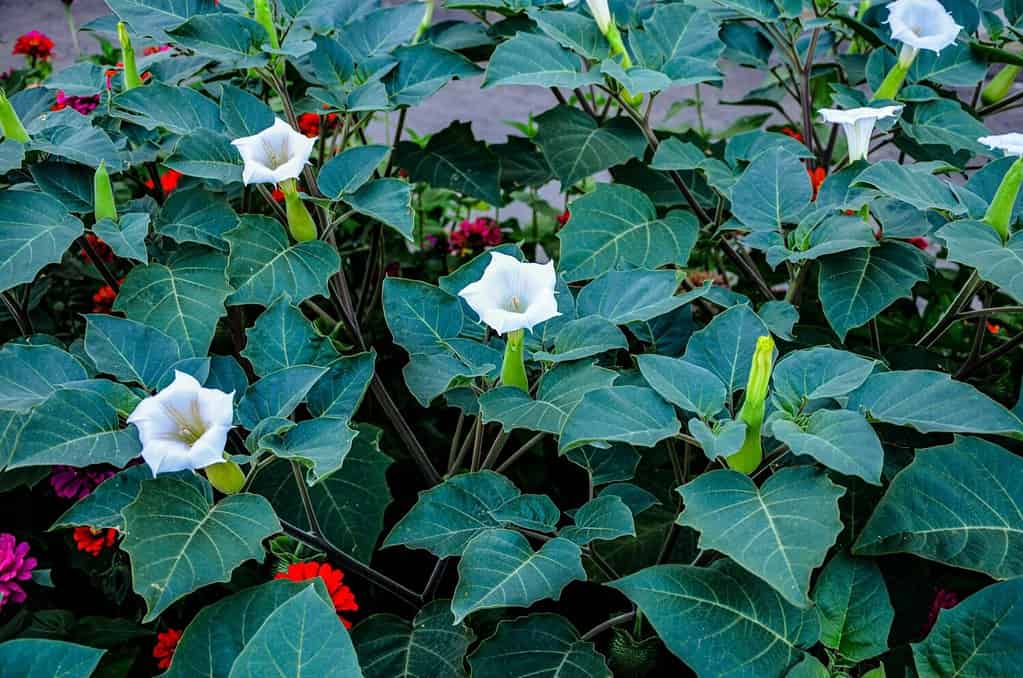
The jimsonweed plant is poisonous to animals and humans.
©weha/Shutterstock.com
Though its trumpet-shaped blooms are striking, jimsonweed is one of the most dangerous plants in Illinois. It grows in disturbed areas, waste sites, and along roadsides. You’ll know you’re near this plant when you see its large, prominently lobed leaves and get a whiff of its unpleasant smell. Unfortunately, jimsonweed is also poisonous to animals and humans.
Jimsonweed Toxins
The tropane alkaloids like atropine and scopolamine in jimsonweed plants make them toxic. Ingesting any parts of jimsonweed plants could cause confusion, delirium, hallucinations, seizures, coma, and death.
4. Water Hemlock (Cicuta maculata)
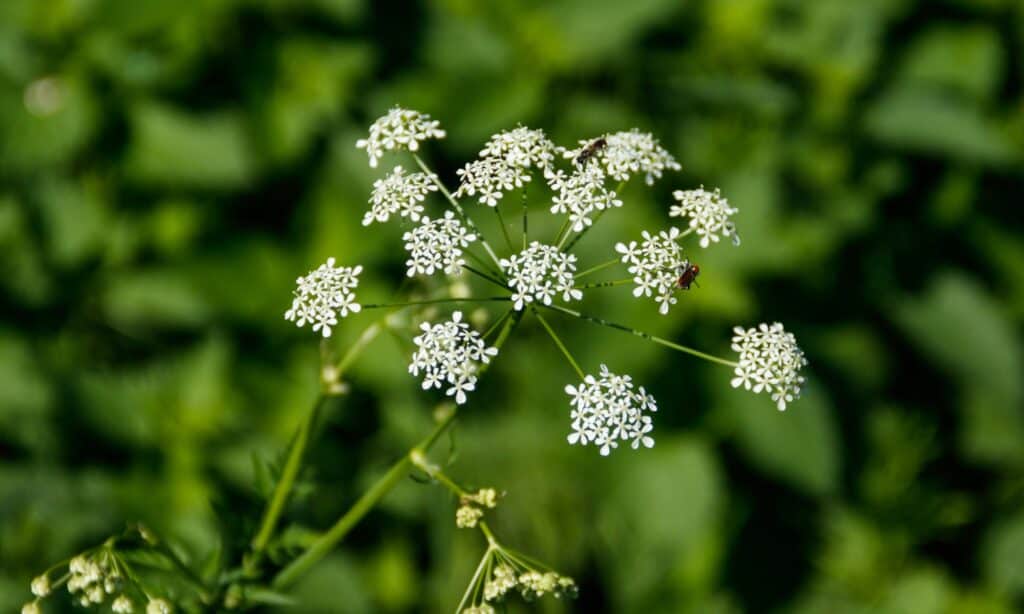
Highly poisonous water hemlock has small flower clusters and spotty stems.
©iStock.com/OlyaSolodenko
Every hemlock plant requires caution, including the highly poisonous water hemlock. This water-loving plant thrives in marshes, swamps, and stream banks. Additionally, water hemlock features white flower clusters on top of tall spotty stems.
Water hemlock resembles Queen Anne’s lace, wild carrot plants, and wild parsley. However, water hemlock is not edible, so be careful when foraging for wild edible plants.
Water Hemlock Toxins
Cicutoxin is a potent neurotoxin in all parts of water hemlock plants, with the highest concentration in the roots. Symptoms of ingesting water hemlock could include nausea, vomiting, tremors, seizures, respiratory failure, convulsions, and death.
5. Poison Ivy (Toxicodendron radicans)
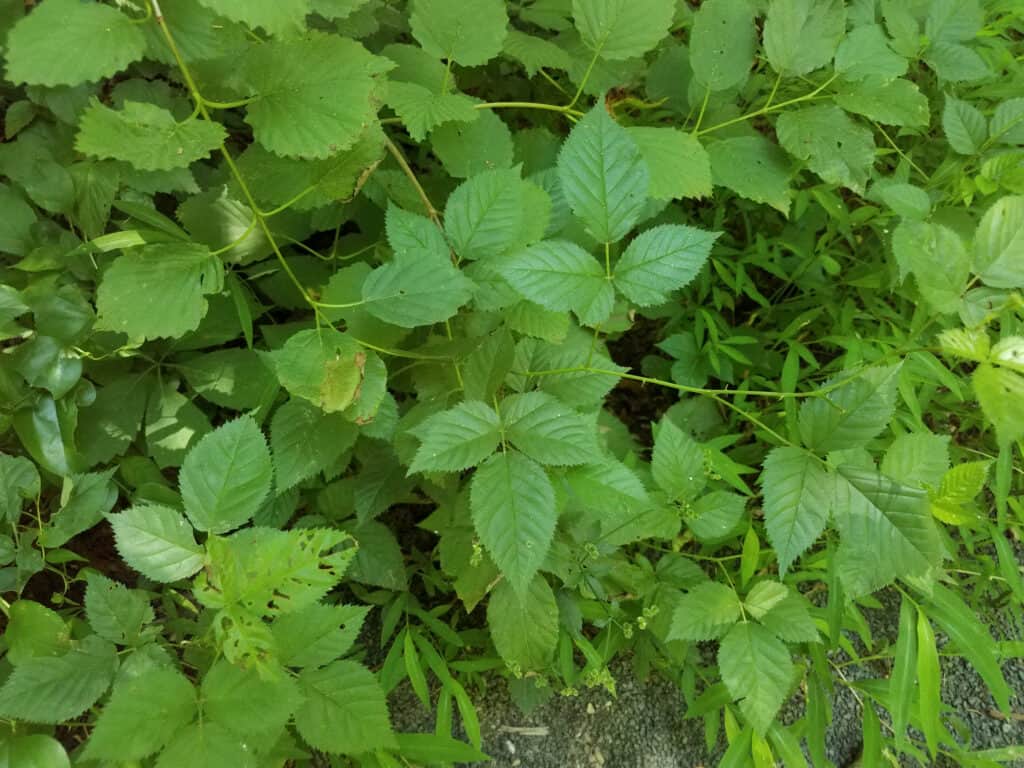
Urushiol is the toxin in poison ivy that causes skin rashes and blisters when you touch it.
©iStock.com/Justin Smith
Most of us know that touching poison ivy is a bad idea, but do you know how to recognize it when you see it? Poison ivy is a woody vine or shrub with compound leaves in three leaflets. And it can trail along the ground or up a tree up to 75 feet! For this reason, it’s essential to watch for this plant’s poisonous leaves all around you.
Poison ivy typically grows in forests and wooded areas. It also grows along trails and open fields.
Poison Ivy Toxins
Urushiol oil, found in the sap of this plant, causes an allergic reaction in many people who touch poison ivy. Symptoms of urushiol poisoning can last from a couple of days to a couple of weeks. Poison ivy symptoms include redness, swelling, itchiness, and blisters. Additionally, inhaling the smoke from burning poison ivy could lead to difficulty breathing.
6. Wild Black Cherry (Prunus serotina)
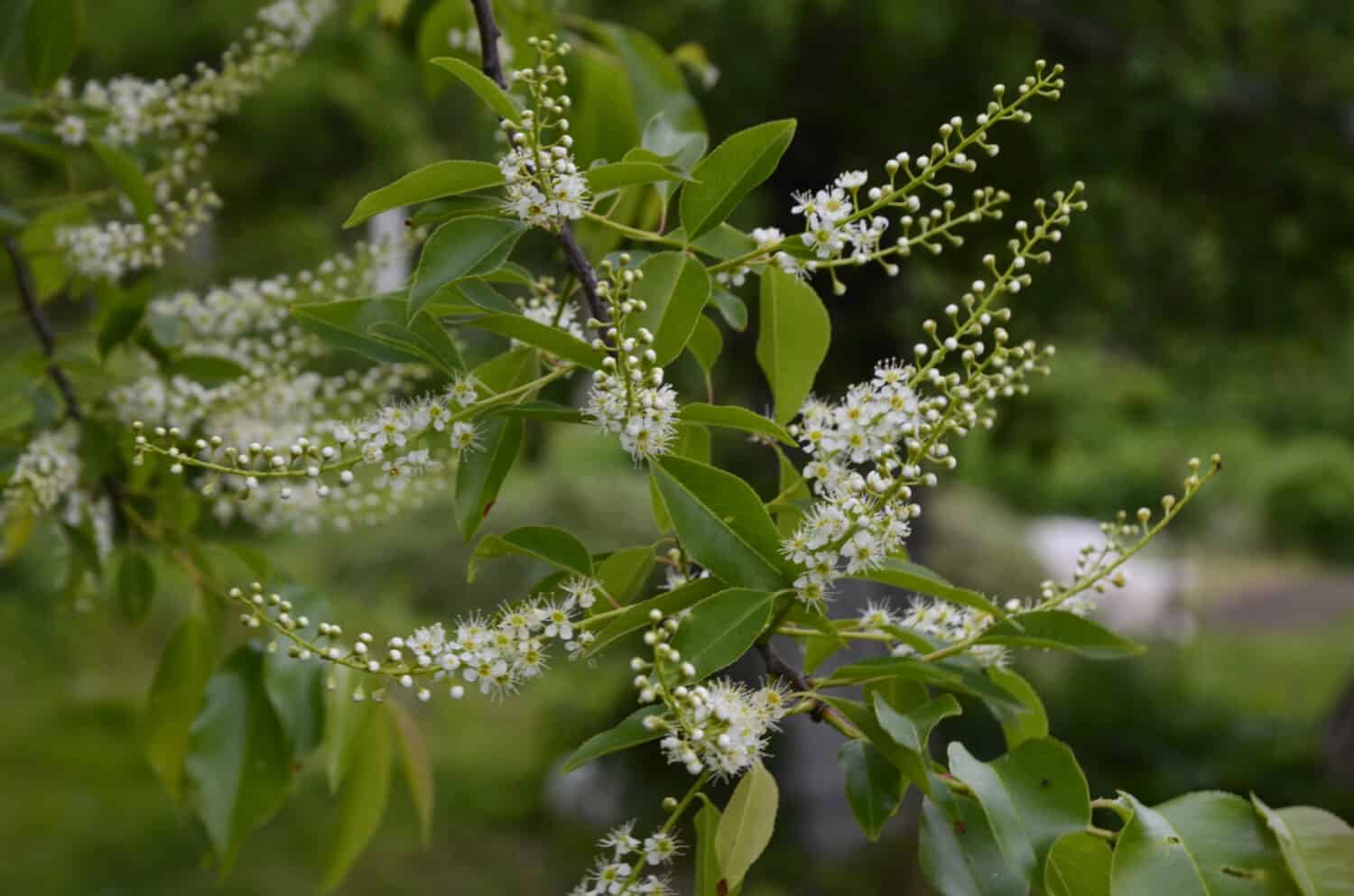
Most parts of the wild black cherry tree (including the cherry pits) are poisonous.
©weha/Shutterstock.com
The wild black cherry tree has dark, shiny bark and clusters of small white flowers on long-hanging racemes. Each of its many tiny flowers has 15-22 stamens, making them look from a distance like they have hair. This common Illinois plant also produces small black cherries. According to the USDA Natural Resources Conservation Service, the cherries of Prunus serotina are edible. However, the rest of the plant (including the cherry pits) produces toxins that make them poisonous.
Wild Black Cherry Toxins
The leaves, bark, seeds (cherry pits), and twigs of the wild black cherry contain toxic cyanogenic glycosides. These toxins are released when these parts of the tree are smashed, chewed, or similarly disturbed. Symptoms of poisoning from ingesting too much cyanogenic glycoside include heavy breathing, convulsions, weakness, seizures, and death.
7. Poison Hemlock (Conium maculatum)
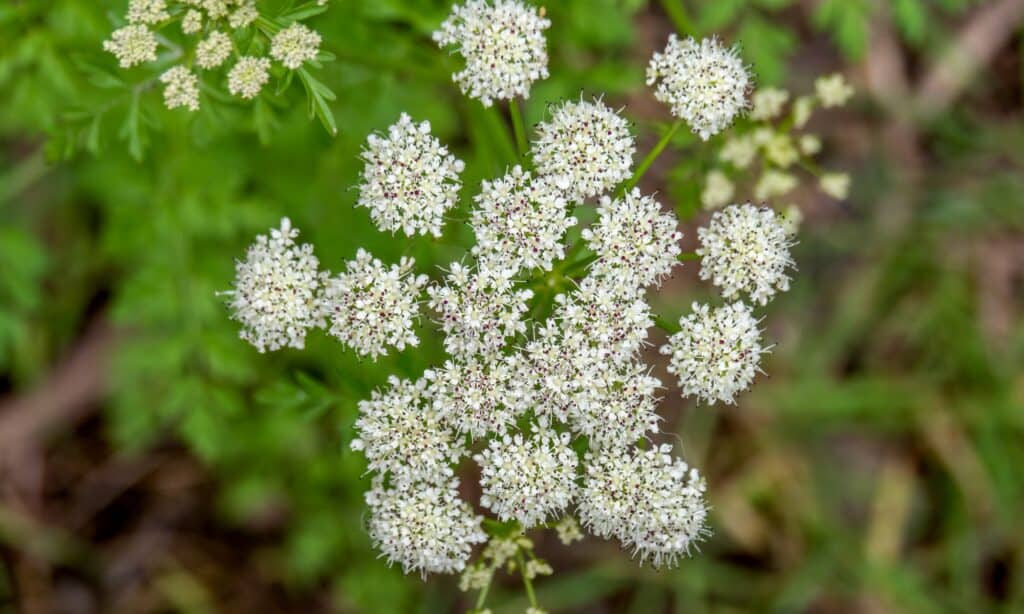
Poison hemlock is highly poisonous and one of the most dangerous plants in Illinois.
©iStock.com/Goldfinch4ever
Another hemlock plant on our list is the highly toxic poison hemlock found in waste areas and damp soil, like stream banks. This tall (4-9 feet) plant has hollow stems, small white flowers arranged in umbrella-shaped clusters, and fern-like leaves. And it remains highly poisonous even after it dies.
Poison Hemlock Toxins
The poison hemlock produces potent alkaloids, including coniine. These compounds are so powerful that they can cause severe toxicity symptoms after ingesting small amounts of the plant. Poisoning symptoms include nausea, vomiting, dry mouth, dizziness, weakness, paralysis, seizures, respiratory failure, and potentially fatal organ failure. Know that ingesting any part of this dangerous Illinois plant can be deadly.
8. Foxglove (Digitalis purpurea)
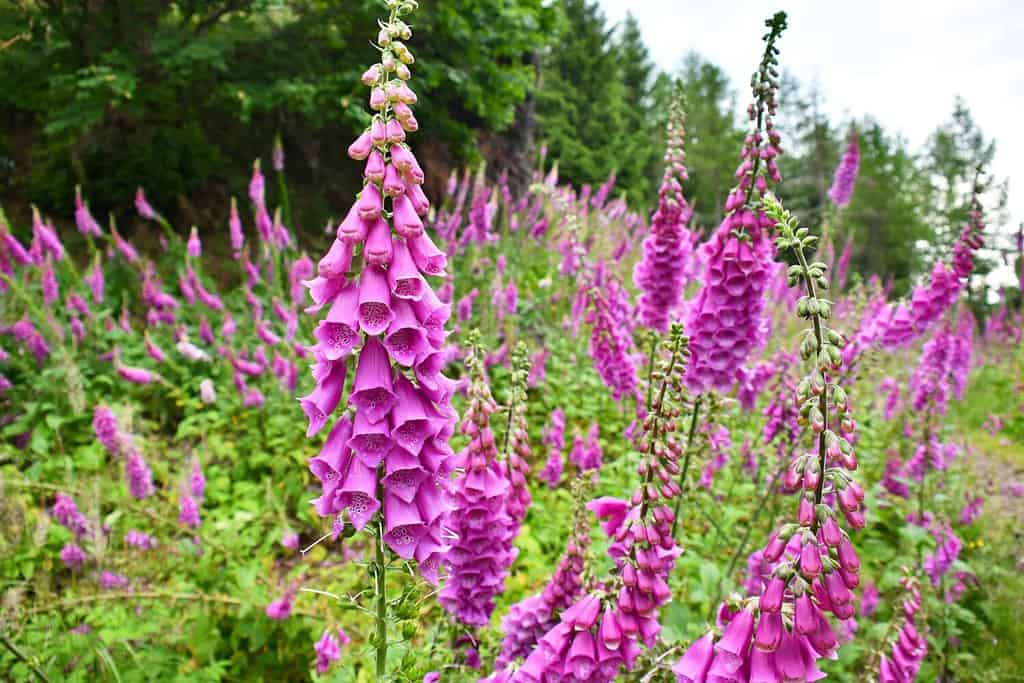
Beautiful foxglove plants contain cardiac glycosides that make them poisonous.
©HAL-9000/Shutterstock.com
Showy foxglove is a tall plant with tubular flowers ranging from pink to purple. It has large, hairy leaves near the bottom of the plant that form a basal rosette. Unfortunately, this striking wildflower is also dangerous in Illinois, growing in gardens, woodlands, and along roadsides.
Foxglove Toxins
The foxglove plant contains cardiac glycosides, particularly digoxin, that make all parts of this plant poisonous if ingested. The symptoms of poisoning include nausea, vomiting, an irregular heartbeat, blurred vision, confusion, depression, collapse, hallucinations, and potentially death.
9. Wild Parsnip (Pastinaca sativa)

The wild parsnip plant contains toxic sap that can burn your skin.
©iStock.com/RuudMorijn
They share part of their name with an edible vegetable, but wild parsnip plants are poisonous. Wild parsnip is a tall, herbaceous plant with small yellow flowers arranged in an umbrella-like shape. It also has a long central stem that reaches up to five feet high. You might see wild parsnips growing in disturbed areas or fields but don’t touch these toxic plants. Their sap could burn your skin.
Wild Parsnip Toxins
When you pair sunlight with the chemical compounds in the sap of wild parsnip, you end up with a dangerous plant you should not touch. The furanocoumarins in wild parsnip plants provide a defense against insect pests. However, they can also cause humans some painful rashes and blisters. Additionally, in extreme cases, skin burns from wild parsnips could lead to scarring.
10. White Snakeroot (Ageratina altissima)

The poisonous white snakeroot plant can cause “milk sickness” in cows.
©Nahhana/Shutterstock.com
The white snakeroot is a dangerous plant in Illinois that produces small clusters of dainty white flowers and coarsely toothed leaves. It often forms dense stands in shaded areas of woodlands, thickets, and wooded fields.
Many pollinators love this nectar-filled plant, but white snakeroot is occasionally toxic to humans and animals. Humans could develop poisoning from consuming contaminated meat or milk from animals that ate white snakeroot plants. However, due to modern food safety precautions, these cases are rare.
Additionally, cows with this plant poisoning could pass it on to their young through milk. This type of poisoning is called “milk sickness.”
White Snakeroot Toxins
The main toxin in white snakeroot is tremetone. Symptoms of white snakeroot poisoning include weakness, loss of appetite, tremors, abdominal pain, and potentially fatal respiratory failure.
Learn to identify the most dangerous plants in Illinois.
While Illinois offers a wide array of interesting and harmless plants, outdoor lovers should keep the dangerous ones on their radar. Many of the most dangerous plants in Illinois are touchable, but that’s not the case for all of them. And none of them are safe to eat! So keep your plant identification guide handy with your protective clothing and first aid kit. Enjoying Illinois nature can be safe and a lot of fun with a bit of education and taking extra precautions toward avoiding the risks of dangerous plants.
Summary of the 10 Most Dangerous Plants in Illinois
| Poisonous Plant | Toxicity | |
|---|---|---|
| 1 | Eastern Black Nightshade (Solanum ptychanthum) | Contains the toxic alkaloid solanine that can cause gastrointestinal symptoms like diarrhea, stomach cramps, nausea, and vomiting, and more serious life-threatening symptoms |
| 2 | Pokeweed (Phytolacca americana) | Contains toxins like phytolacca and saponins that cause nausea, vomiting, diarrhea, convulsions, stomach cramps, and respiratory failure, which could be fatal |
| 3 | Jimsonweed (Datura stramonium) | Toxins scopolamine and atropine can cause dry mouth, rapid heartbeat, confusion, dilated pupils, blurred vision, hallucinations, coma, and possibly death |
| 4 | Water Hemlock (Cicuta maculata) | Contains potent cirutoxin which causes tremors, seizures, respiratory failure, nervous system failure, and death |
| 5 | Poison Ivy (Toxicodendron radicans) | Toxin called urushiol causes itchy skin rash, swelling, and blistering |
| 6 | Wild Black Cherry (Prunus serotina) | Contains toxic cyanogenic glycosides that can cause heavy breathing, convulsions, weakness, seizures, and death |
| 7 | Poison Hemlock (Conium maculatum) | Powerful neurotoxins including coniine can cause weakness, nausea, vomiting, dizziness, convulsions, muscle paralysis, respiratory failure, coma, and death |
| 8 | Foxglove (Digitalis purpurea) | Contains cardiac glycosides like digoxin that cause nausea, vomiting, an irregular heartbeat, blurred vision, confusion, depression, collapse, hallucinations, and potentially death |
| 9 | Wild Parsnip (Pastinaca sativa) | Chemicals called furanocoumarins can cause phytophotodermatitis, symptoms including an itchy and burning rash, blisters, and possible scarring |
| 10 | White Snakeroot (Ageratina altissima | Contains tremetone which can cause weakness, loss of appetite, tremors, abdominal pain, and potentially fatal respiratory failure |
The photo featured at the top of this post is © iStock.com/Elmar Langle
Thank you for reading! Have some feedback for us? Contact the AZ Animals editorial team.







